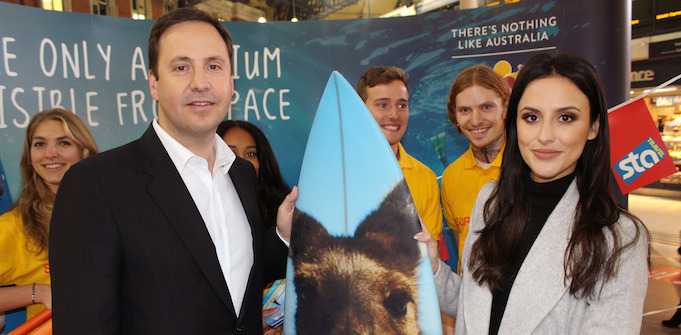
Source: AAP/Lloyd Jones
When it comes to official campaigns to promote tourism to Australia, there seems to be an obsession with lifeguards. But when it comes to getting people to travel from overseas for work and play, branding experts say the best campaigns are not even run by the tourism office.
Minister for Tourism Steve Ciobo was on deck in London yesterday at a “pop up beach” created in Victoria train station, with the star of UK reality TV show Made in Chelsea Lucy Watson. The idea was to promote Australia as a destination for young working holidaymakers as part of a $10 million government campaign, but there wasn’t any sand, and reportedly the young people dressed up as lifeguards at the scene were not genuine Bondi Rescue cast members but Brits who had never actually been to Australia.
While Australia is keen to suggest to Britons that Australia is a promising location for work and play in a post-Brexit world, observers were cynical about the effectiveness of the pop-up beach campaign.
ABC reports that train station staff were even concerned about TV crews arriving to film the press conference with Minister Ciobo and Lucy Watson.
The campaign comes after the government confirmed in September that its “backpacker tax” would be revised and working holiday visa holders instead look set to be charged 19c in the dollar from their first pay checks. At the time, local backpacking advice groups on social media seemed to welcome the revision, but some were concerned about new rules about superannuation that would see workers’ super taxed at 95% upon leaving the country.
So will a government tourism campaign encourage more travellers from Britain to venture Down Under? SmartCompany spoke to branding experts this morning and many could not think of a recent example of a campaign that worked well for generating international traffic to local businesses.
Read more: Northern Australian SMEs to share in $16.3 million tourism initiative
The best examples seemed to come not from Tourism Australia, but from local businesses who have been able to pitch the diversity of the country as a holiday destination.
The “Still Call Australia Home” campaign run by Qantas in the 1990s is has an enduring impact even today, says InsideOut PR director Nicole Reaney.
“This pulled on the emotional heartstrings and made Australian consumers proud of living here by personifying beauty – it also successfully positioned Australia as a stunning and alluring destination for overseas travellers,” she says.
It’s also a story that keeps delivering, with news recently that two people who met while filming the ad got engaged earlier in the year in front of Uluru, where the ad was filmed.
Social media expert at CP Communications, Catriona Pollard, also cites Qantas as a good example of effective advertising for the nation – especially online.
“Qantas is doing a really interesting [campaign] at the moment where you upload your photos of three favourite places in Australia,” she says.
“One is of food, one is related to nature. And what I like about that is that you’re asking people to share their own images,” Pollard told SmartCompany.
That sense of authenticity is crucial when courting overseas travellers – as is reminding them that the country is not just about beaches.
“It adds more layers and complexities to what it’s like to be in Australia,” Pollard says.
Australians love to complain about how the country is sold on social media, but the truth is that even the campaigns that have provided cultural cringe back home have something to offer an the overseas audience, says Reaney.
While the infamous “Where the Bloody Hell are You?” ad featuring Lara Bingle was a target of derision for years, it did have a lasting impact. “The sheer global publicity generated by the campaign can’t be denied,” she says.
Meanwhile, it seems that “Shrimp on the Barbie” still holds the title of most memorable attempt at generating interest in the country, not least because it used “the intrigue and popularity” of Paul Hogan while promoting Australian landscapes at the same time, says Reaney.
When it comes to the latest backpacker campaign, Pollard believes when organising stunts, you just have to accept that some won’t work – though perhaps the timing of this one was a little off if people were to really get behind sharing it on social media.
“Time is really critical with that kind of thing- if you’d done it in really freezing cold London and shown sunny Australia, for instance,” she says. Today London is heading for a top of 16 degrees – not that different from Melbourne’s 18 degrees or even Sydney’s top of 21 over the weekend.
Tourism Australia has been given an additional $10 million in funding as part of the federal government’s overhaul of the working holiday visa program and has flagged an intention to run a digital-focussed campaign.
Yesterday’s announcement also included a deal between the Australian government and youth travel agency STA to target UK travellers that are considering Australia as a destination.
“Our Working Holiday Maker program provides the perfect launch-pad for a life-changing year, maybe even two, combining travel with temporary work,” said Tourism Australia managing director John O’Sullivan in a statement.


COMMENTS
SmartCompany is committed to hosting lively discussions. Help us keep the conversation useful, interesting and welcoming. We aim to publish comments quickly in the interest of promoting robust conversation, but we’re a small team and we deploy filters to protect against legal risk. Occasionally your comment may be held up while it is being reviewed, but we’re working as fast as we can to keep the conversation rolling.
The SmartCompany comment section is members-only content. Please subscribe to leave a comment.
The SmartCompany comment section is members-only content. Please login to leave a comment.